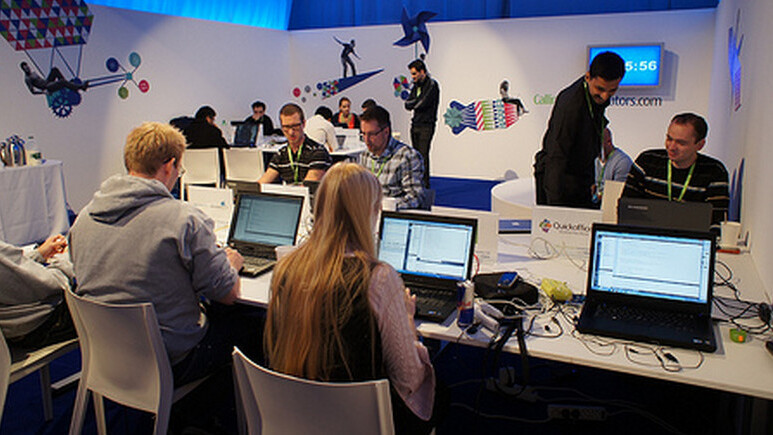
Today Microsoft released an update to its App Hub for developers building Windows Phone 7 applications.
Perhaps most important among Microsoft’s announcements on the matter is that developers can begin to submit applications designed to run on Mango, the next version of Windows Phone 7, in August. This jives well with reports that Mangoed WP7 handsets are set to land in either August, or September.
Microsoft also announced that developer interest in WP7 had recently risen, with the rate of new developer sign ups growing in the past few months. There are now ‘tens of thousands’ of developers using the new Mango tools, the company claimed.
Also released today is access for developers to sell their apps in 19 new markets. And, Microsoft expanded the number of countries that can submit applications by 7. Those two moves should help to both boost app sales, and maintain developer momentum. Finally, Microsoft Advertising pubCenter will be available in 18 countries by the end of the year.
Mango will bring a sheaf of new capabilities to the consumers who own WP7 handsets, but it is also set to make the development experience far more enjoyable. We ask the question again: Why wasn’t this the case when the phone line launched? It feels like now, at last, Microsoft has a complete developer platform in place, almost a year post launch.
The full Microsoft changelog can be found below:
New App Hub functionality and geographic expansion:
1. Geographic expansion: A large part of your success in Marketplace hinges on your app’s discoverability and reach. I’m excited to announce a number of new consumer and developer markets to help get your app in front of more people.
- 19 new consumer markets. Starting today developers can publish their apps to consumers in 19 new countries, in addition to the 16 that Marketplace already supports. The 19 new markets include Brazil, Chile, Colombia, Czech Republic, Denmark, Finland, Greece, Hungary, India, Japan, Netherlands, Norway, Poland, Portugal, Russia, South Africa, South Korea, Sweden and Taiwan.
- 7 new developer markets: Also starting today developers from 7 new markets (Welcome!) can register in App Hub and submit apps. The 7 new developer markets enabled include: Chile, Colombia, Czech Republic, Hungary, Israel, South Africa and South Korea.
- In a couple of months (early fall 2011), developers will also be able to register from China. We will also expand the registration support already available in India.
- App Hub localization: App Hub is now localized for Korean and Simplified Chinese in addition to English and Japanese.
- Updated price tiers: Periodically (such as with the addition of new markets) we modify price tiers on a country-by-country basis to adjust for fluctuations in global currency exchange rates. The goal is to maintain consistent application pricing (net of applicable taxes) across markets. During the nine months since our initial launch, some currencies have gained and some have lost strength relative to one another. The changes made this week bring global prices more closely in line with the values established 9 months ago. We’ve also added more pricing tier options below (US) $5 to give you more flexibility in pricing.
- Upcoming mobile in-app advertising market expansion: The international availability of Microsoft pubCenter remains a priority so developers can receive mobile in-app advertising revenue in their local currency. To this end, Microsoft Advertising pubCenter will support Windows Phone 7 app developers in the following 18 countries by the end of 2011: Australia, Belgium, Canada, Denmark, Finland, France, Germany, Hong Kong, India, Italy, Japan, Mexico, Netherlands, Norway, Spain, Sweden, Switzerland and the United Kingdom.
To enhance developers’ long term success with ad funded Windows Phone 7 apps, we continue to offer more effective ad monetization and expand overall demand.
- Earlier this week, two developers used their apps to compare which advertising platform helped them make more money – Microsoft Advertising or another ad platform. After a nearly three week period, the Microsoft Advertising SDK for Windows Phone 7 drove a 71% higher yield, producing greater overall gross revenue earnings and fill rate. See the blog post for more details.
- Last month we announced the availability of Windows Phone 7 in-app inventory to all demand sources (e.g. ad networks) on the Microsoft Advertising Exchange for Mobile in any of the 17 countries where the Windows Phone Marketplace is currently live. Over a dozen new demand sources, including ChoiceStream and Suite 66, can now bid in real-time for this valuable in-app inventory increasing bid density.
2. New private distribution options: Developers can now choose to distribute apps privately to users using two new options: beta and/or targeted distribution. Apps distributed through these private distribution methods can only be downloaded by users using a deep-link and the apps cannot be discovered via browsing or searching in Marketplace.
- Beta Distribution: Enables developers to distribute pre-certified applications to a group of up to 100 access controlled beta testers for up to 90 days. This distribution method gives you the opportunity to test apps with a hand-picked set of beta testers more quickly and build high-quality apps before publishing them in Marketplace.
- Targeted Distribution: Enables you to distribute applications through Marketplace in a hidden state, where they are not discoverable via browsing or searching Marketplace. To enable targeted users to access your hidden app you simply share the deep-link to the app with the users you want to have access via e-mail, text or other mechanism. Unlike beta distribution, you may distribute your app to as many users as desired and publish publicly in Marketplace at any time.
3. Enhanced application management: For Mango, we’ve also heard your feedback and made lots of improvements, big and small, to App Hub to give you better account management tools, a streamlined application submission process and enhanced reporting capabilities.
- Better application management: By selecting ‘Edit catalog details’ on the app ‘Lifecycle’ tab you can now change the app metadata without submitting your app for re-certification, thus reducing the time to update and publish new information.
- Enhanced developer dashboard: Now from a single location, when you sign-in you can quickly see all top app performance metrics, payout status, distribution reporting and all available ratings & reviews on your app(s) on a per language basis.
- More detailed reporting: You are now able to select between ‘Summary’ and ‘Detail’ views of all reports and export them in an Excel-compatible format for offline data handling and analysis.
- New ‘Crash Count’ report: App Hub now enables you to retrieve data on crash counts and stack traces for each of your apps to use in debugging publisher updates faster.
- Streamlined application submission process: Developers no longer need to upload artwork files one-by-one. By clicking the ‘Browse’ button, developers can bulk select upload multiple artwork files all at once during the app submission process. The App Hub will automatically detect the image sizes of all artwork and place them in the correct artwork locations for developers to edit or delete before final app submission.
New App Categories: To make discoverability of apps easier we have added 3 new top level categories (education, kids & family and government & politics) and several new sub categories. In addition, during the app submission process, developers can now select categories and sub-categories for all languages.
Get the TNW newsletter
Get the most important tech news in your inbox each week.




